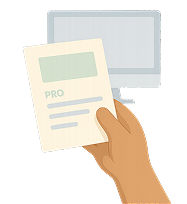What is a soft launch?

A full-scale launch is launching your product, service, or app directly to customers. A full-scale launch can be risky because even though the production process is quite long, you might still be missing out on some information that the target audience for the product or service would care about. Soft launch is a strategy that aims to create a safer and better examined full-scale launch for your products or services. With a soft launch strategy you release a product or service to a limited audience and in this way, you can test the effectiveness, performance, and market reception of it before launching it full-scale. This method helps companies minimize their risk of not reciprocating the product or service after a hard launch. Through soft launching strategy, organizations can identify and address any issues, gather user feedback, and make necessary adjustments to improve the product or service. During this beta version phase, users typically expect to encounter glitches, bugs, or friction in the app experience.
Are you having trouble finding a brand name before soft launching your product? No problem! Learn how to create a brand name with artificial intelligence by reviewing our article titled Brand Name Generation Tips with AI!
How to soft launch?

We have discussed the important role of soft launching strategy especially when it comes to reducing risks proactively for launching a product or service. Following these steps has led to successful soft launches for many companies. Now lets list how an organization can soft launch, step by step below:
-
Define Objectives
-
For starters, you need to be clear on defining your expectations from the soft launch. Those expectations can be focused on gathering user feedback, measuring the market reaction to the products or service, or testing operational processes.
-
Select a Target Audience
-
It is highly likely that the products or services you create already have a target audience from a business stand-point. As you aim for a target audience for a full-scale launching process, you need to take a representative target audience of the target audience you already have in mind. This representative target audience can give you enough information about your product.
-
Prepare the Product
-
In the soft launch process, you need to launch a product or service that is functional enough, but also has a room for adjustments based on feedback. You need to prepare the product you will soft launch based on this principle of improvement and high representation.
-
Develop a Feedback Mechanism
-
One of the main aims of the soft launch process is to gather feedback from the target audiences of the products or services. You need to create a functional feedback recollection system from users, such as surveys, in-app feedback tools, or direct communication channels.
-
Implement Marketing Strategy
-
You need to create a targeted and low-key marketing strategy to deliver your soft launch product or service to a small, representative target audience without it gaining widespread recognition.
-
Launch the Product
-
After you follow each of the steps above including defining your objective, choosing a target audience, preparation of the product or the app, developing feedback mechanism, and creating a unique marketing strategy; you can soft-launch your product or service. After soft-launch, do not forget to monitor the product closely which brings us to the next step.
-
Collect and Analyze Data
-
After soft-launch, you need to continuously collect and analyze data for the soft-launch to be effective and serve its purpose. Collect data on user behavior, performance metrics, and feedback to identify issues and areas for improvement. You will need all those collected data in the step to make adjustments.
-
Make Adjustments
-
Collecting data is not enough for your soft launch to be successful unless you make a use out of it. Use the data and your analysis to make improvements, fix bugs, and enhance user experience.
-
Prepare for Full Launch
-
After the collection and analysis of data and making the necessary adjustments based on the data; you are finally ready for the full-scale launch! You can now offer the best and the most improved version of the products or the services to your target audience.
Do you want to find the best social media agency after soft launching your brand? To find the most suitable social media agency, explore our content titled How to Find a Social Media Marketing Agency for Your Business!
When to soft launch?

We have discussed what soft launch is and how to make a successful soft launch step by step. However, not every product or service might need a soft launch, but when can we know if it does? Let’s visit some scenarios where your product or service might need soft launching.
-
If you have almost developed the product, but it is still not for a full-scale launch, you might benefit from soft launch.
-
You can soft launch if you want to collect data and user feedback before the official launch and make a few more adjustments based on these.
-
If you are opening to a new market or demographic, soft launching can be really helpful to create the best strategies for them.
-
Last but not least, you can really benefit from soft launching to minimize the risks you would take by a full-scale launch. A soft launch overall helps you identify and address any potential problems much more early.
-
A soft launch might delay immediate revenue, but it can provide valuable insights and reduce long-term risks.
Do you know about landing pages? Check out our content titled What Is a Landing Page to discover.
Why do we need soft launch?

We have discussed some overall benefits of soft launching. Let’s now list all benefits of soft launching and why we need to increase effectiveness and success.
-
Risk Management: Arguably the most important function of a soft launch is that it helps you identify and fix issues before your product reaches the masses.
-
User Feedback: Soft launch allows you to gather customer reviews and insights. You can use those reviews and insights to make adjustments and to create a better end result.
-
Market Testing: Your target market may not receive the product or the service as you planned. This might create a huge waste of time and resources for you. Soft launching tests the market reception and demand for you.
-
Performance Evaluation: You need soft launch to test, assess, and evaluate the product’s performance with real target audiences.
-
Cost Efficiency: Fixing any bugs or problems after a full-scale launch would be so much more expensive and require much more time and effort. A soft launch is much more cost efficient.
-
Preparation for a Successful Hard Launch: Insights gained from a soft launch can contribute to a successful hard launch by ensuring the product is polished and meets user expectations. A successful hard launch requires launching a product that feels professional and has the least amount of bugs possible for app users.
Do you need e-mail marketing solutions for your soft-launched product? No need to worry! Learn about email marketing by reviewing our article Email Marketing 101: Basic Principles for Beginners!
What are the negatives of a soft launch?
We have discussed some overall benefits of soft launching while also underlining why we need soft launching. Now, let’s look at the other side of soft launching with some negative qualities to create a better understanding of the process.
-
Limited Exposure: A soft launch may not be sufficient to create a difference in sales or marketing aspects. In contrast, hard launches offer high visibility and immediate impact, though they come with high-stakes and require significant preparation and market research.
-
Potential for Negative Feedback: A soft launch allows you to detect bugs and other issues. You can later work on these bugs and issues. However, early users might create a prominent negative perception about the product based on those problems which can be damaging to your overall brand image.
-
Resource Allocation: Even though soft launch has some benefits including cost efficiency, it can also require more time and resources to monitor and adjust based on feedback.
-
Market Confusion: Soft launching must be communicated clearly with the market. In other cases, it can confuse the target audiences and create confusion about your product’s qualities.
Soft launch checklist: How to soft launch step by step?

Here is a checklist about soft launch for you. If you need more explanation on each step, you can visit our answers to the question “How to soft launch?”. In the answers of that question, we explained each step clearly.
-
Set Clear Goals
-
Identify Target Audience
-
Ensure Product Readiness
-
Establish Feedback Channels
-
Plan Marketing Strategy
-
Launch to Selected Audience
-
Monitor Performance
-
Collect User Feedback
-
Analyze Data
-
Implement Improvements
-
Prepare for Full Launch
Do you need identity design ideas for your brand? Click on our 100+ Corporate Identity Design Examples content to see the best corporate identity design examples!
What are the examples of soft launching?

Successful Soft Launch Examples
Facebook Soft Launch Example
-
Facebook initially launched exclusively to Harvard students as “The Facebook”. Then, Facebook slowly expanded to other Ivy League universities. Later, the expansion continued with other colleges, and eventually to the general public. This slow and controlled expansion and soft-launching process of Facebook allowed it to grow systematically. Facebook still follows this approach and improves itself based on customer feedback and preferences. Much like soft launching a new relationship on social media, this cautious and gradual approach helped Facebook manage its growth effectively.
Instagram Soft Launch Example
-
Instagram started with a small group of iPhone users in San Francisco. Later, Instagram collected feedback on user experience and performance and made some improvements before launching the app to a broader public. This approach allowed Instagram to create a user-friendly experience and facilitated its growth. Instagram still holds this innovative and improving approach based on user-experience.
Angry Birds Soft Launch Example
-
Angry Birds was first only launched in Finland. In Finland, they tested the game’s many qualities such as its user engagement, operational qualities, and customer responses. The soft launch provided a guideline about further optimization for the game before the global release. This approach contributed to the Angry Birds’ global success after full-scale launch.
Snapchat Soft Launch Example
-
Snapchat was initially launched as “Picaboo” to a very small group of users. After the soft launch, the teams gathered user feedback and they rebranded Snapchat with improved features. This slow and controlled soft launch allowed for further improvements and created a basis for Snapchat’s global popularity among a broader audience.
Spotify Soft Launch Example
-
Spotify was initially only soft launched in Sweden and other Nordic countries. The team of Snapchat tested streaming capabilities, user interface, and music licensing processes with this first soft launch process. With the information gathered from the soft launch process, Snapchat improved its service and gained a global dominance in music streaming apps.
Uber Soft Launch Example
-
Uber was initially only soft launched in San Francisco with a few cars and users. Uber tested its service, user experience, and backend systems during this first soft launch process. Those feedback allowed Uber to scale up their operations successfully and catalyzed the expansion of Uber. Uber continued to have this improvement approach after its hard launch as well and created new improvements such as Uber Eats.
What is a hard launch?

A hard launch, or a full-scale launch, refers to the release of a product or service to the entire target market. With a hard launch, you need to engage in high-profile marketing processes and aim to maximize visibility and sales even at the very beginning. Unlike a soft launch, hard launch aims to put forward a product that is fully developed and ready for the users. Intensive marketing campaigns, media coverage, and promotional events are usually common characteristics of hard launch processes. Those high scale marketing campaigns aim to create a significant impact in the market and increase the sales with aggressive market growth. Much like hard launching a new boo on social media, where the relationship is showcased openly and publicly, a hard launch for a product seeks to capture immediate and widespread attention. You can see the differences between hard launch and soft launch compared with different aspects on the table below.
Soft launch vs. Hard launch
|
Aspect |
Soft Launch |
Hard Launch |
|
Scale |
Small scale, limited geographic area or user group |
Large scale, broad market exposure |
|
Objective |
Test product/service, gather feedback, identify issues |
Maximize visibility, generate buzz, achieve sales targets |
|
Focus |
Feedback collection, performance evaluation |
Marketing, brand awareness, sales |
|
Timing |
Early stage before full release |
Final stage, product/service fully ready |
|
Risk Management |
Minimizes risk by identifying and addressing issues early |
Higher risk due to public exposure |
|
Flexibility |
Allows for adjustments and improvements based on feedback |
Limited flexibility, little room for error |
|
Marketing Approach |
Low-key, targeted marketing efforts |
High-profile, extensive advertising campaigns |
|
Outcome Expectation |
Learning and refining product/service |
Immediate market impact, achieving sales goals |
|
Example |
Beta testing a software app in a specific city |
Launching a new smartphone globally |
Do you need to contact the best mobile app agencies to soft launch your product? Find the most suitable mobile app company for your brand by browsing our content titled Best 15+ Mobile App Companies! See the details of Best 15+ Mobile App Companies in Washington DC!
What is a pre-launch?

A pre-launch is a phase in the product development and marketing process. Unlike soft launch, pre-launch occurs before any release to the public whether it is soft launch or hard launch. Pre-launch aims to create excitement and anticipation within the target audience by increasing their interests. You can think of a pre-launch as a trailer of a movie, like the trailer, pre-launch aims to create a curiosity and make people talk and expect the product. Pre-launch campaigns may include teasers and sneak peeks, again just like trailers. During this pre-launch period, you can collect data and feedback from your target audience and make sure that you are following the right strategies. Successfully applied pre-launch can help you create a reliable and solid base for a successful official launch. You can make sure that you have users waiting for your products or services through effective pre-launch. The table below shows the differences between pre-launch and soft launch compared with different aspects.
Pre-launch vs. Soft launch
|
Aspect |
Soft Launch |
Pre-Launch |
|
Timing |
Occurs after the product/service is mostly developed, but before full-scale release |
Happens before the product/service is fully developed and ready for market |
|
Purpose |
Test the product/service in a live environment with a limited audience to gather feedback and make improvements |
Build anticipation, collect leads, and gauge interest before the official launch |
|
Scope |
Limited to a specific geographic area, user group, or market segment |
Typically broader in scope, aiming to reach potential customers across various channels |
|
Feedback |
Focuses on collecting user feedback to refine the product/service |
Gathers initial interest and potential customer feedback to tweak marketing and product/service features |
|
Risk Management |
Helps identify and mitigate potential issues before a full launch |
Reduces the risk of launching to an uninterested or unreceptive market |
|
Marketing Approach |
Low-key, targeted marketing efforts to a select audience |
Teaser campaigns, sneak peeks, and lead generation activities to build excitement and anticipation |
|
Outcome |
Refines the product/service based on feedback, prepares for wider release |
Generates buzz, builds a customer base, and prepares for a successful full launch |
FAQ

-
How long does a soft launch take?
The length of a soft launch process may change and depend on different factors like the feedback from initial users and adjustments needed. However, we can assume that the process would take around a few weeks to a few months based on the factors.
-
Can I play a game in soft launch?
It would depend, but “yes” if you are selected for the initial user group for a newly developed game’s testing period. Soft launches are usually limited to specific areas and user segments, so you would need to be in those segments to play a game that is in the soft launch process.
-
How to do an app soft launch?
You can soft launch an app if you follow the necessary steps of soft launching. Those steps are listed below:
1.Define Goals
2.Choose a Target Market
3.Prepare the App
4.Launch in Selected Region
5.Collect Feedback
6.Make Improvements
You can visit our answers to “How to soft launch?” for overall explanations of those steps. The only difference is that during soft launching an app, you focus more on the mobile app development process.
-
How to do an agile soft launch?
Agile is an effective methodology commonly used in project management and software development processes. Agile development emphasizes flexibility, collaboration, rapid delivery, and continuous improvement and it has unique principles. You can follow agile principles during your soft launch to do an agile soft launch. Let’s see the agile principles and methods step by step.
-
Iteration 1
-
Feedback Adjustment
-
Iteration 2:
-
Feedback
-
Adjustment
-
Repeat
These steps above show how an agile soft launch process would go step by step. Now let’s see the agile principles and methods.
-
Iterative Process
-
Continuous Feedback
-
Rapid Adjustments
-
Incremental Improvements
-
User-Centric Development
-
Daily Stand-Ups
-
Retrospectives
-
Continuous Integration/Continuous Deployment (CI/CD)
These steps above show the principles of agile process. Agile is a fast and continuous process that rapidly and effectively adapts and improves with feedback.
-
How to do a website soft launch?
You can soft launch a website by following the steps below:
Develop the Website
Select a Limited Audience
Prepare Feedback Mechanisms
Launch the Website
Gather User Feedback
Analyze and Improve
Prepare for Full Launch
You can also visit our answers to “How to soft launch?” for more comprehensive explanations of those steps.
-
What are the three types of a product launch?
There are three types of launches; soft launch, pre-launch, and hard launch. You can see the key differences between each launch type below. To summarize, soft launch is launching the product to a limited target audience, pre-launch is creating anticipation among the target users, and hard launch is launching the product full-scale such as launching an app globally.
-
Soft Launch
You release your product, most commonly through an app or website, only to a limited audience. You can test the product, collect feedback, and make improvements with the soft launch.
-
Hard Launch
You release your product to the entire target market. Hard launch usually comes hand in hand with intense marketing campaigns and an aim to increase sales and users.
-
Pre-Launch
Pre-launch consists of all the activities and campaigns made before the official hard launch to create excitement and anticipation among the target market.
-
Is soft launch the same as beta?
Soft launch and beta testing have both similarities and distinct qualities. Both soft launch and beta testing include releasing a product to a limited audience for testing and feedback. A beta testing is made in a controlled environment with aware participants and it aims to find bugs and issues about the product. However, a soft launch is usually a broader market testing in a less controlled environment. A soft launch may include some marketing campaigns to the initial users and it aims at a very small but representative customer segment.
-
What to do during soft launch?
You can follow the steps below for a successful soft launching process:
-
Monitor performance
-
Collect user feedback
-
Analyze data
-
Make improvements
-
Communicate with users
-
Test new features
-
Address bugs and issues
-
Evaluate user engagement
-
Adjust marketing strategies
-
Prepare for full launch
Successfully implementing each of these steps will ensure that you will have an effective soft launch process.
-
What makes a soft launch successful?
Aside from following all the necessary steps of launching that are listed above, you need to have a few principles for a successful soft launch. Those principles are listed below:
-
Clear objectives
-
Targeted audience
-
Effective feedback mechanisms
-
Responsive adjustments
-
Monitoring and analysis
-
Communication with users
-
Incremental improvements
-
Comprehensive testing
-
User-centric approach
-
Preparation for full launch
Each of those principles and approaches will ensure that your soft-launch efforts will create the best possible results.
Do you need to optimize your website traffic after soft launching your product? Find the most suitable SEO agency for your brand by exploring our content titled Best 15+ SEO Agencies! See the details of Best 15+ SEO Agencies in London!
"Get tailored software solutions. Discover the best developers on Edvido."
















